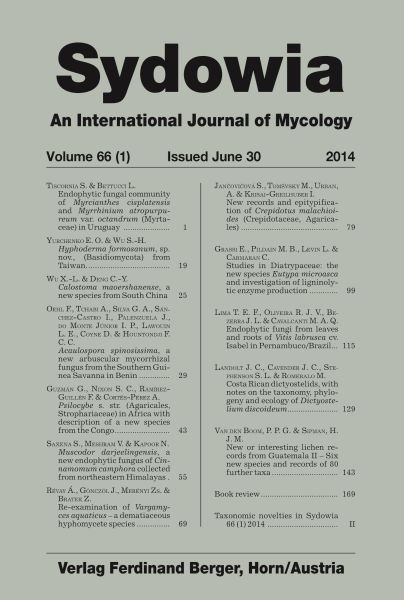
Sydowia Vol. 66/1 E-Book/S 1-17
Endophytic fungal community of Myrcianthes cisplatensis and Myrrh
Download-Artikel
Artikel Nr 2497
Preis 11,00 €
Lieferstatus 

Buchbeschreibung
Tiscornia S. & Bettucci L. (2014) Endophytic fungal community of Myrcianthes cisplatensis and Myrrhinium atropurpureum var. octandrum (Myrtaceae) in Uruguay. – Sydowia 66 (1): 1–17.The main goal of the research presented here was to examine the abundance, diversity, species richness, and taxonomic composition of the endophytic community of Myrrhinium atropurpureum var. octandrum and Myrcianthes cisplatensis (Myrtaceae) and to detect whether differences in hosts, organs and tissue preference exist. An additional aim was to compare the endophytic composition of these native plants with other previously studied and with those of non-native species of Eucalyptus. Identification of fungal isolates was mainly done morphologically. Molecular identification was performed for isolates not sporulating on culture media or those not possible to identify by morphological characters. The majority of endophytes present in both host plants belonged to Sordariomycetes and Dothidiomycetes; Xylariales and Pleosporales being the most frequently isolated. Both hosts have in common the dominant species, Preussia spp., Guignardia mangifera and Alternaria alternata. As the hosts are woody plants from South America neotropical forests located in a temperate region, fungal endophytic communities have an intermediate composition between temperate and tropical climate. Therefore, it is not surprising that both hosts have lower rates of infection with similar diversity in endophytic communities to that of tropical trees. Several species are decomposers, others potential pathogens, biological control agents and secondary metabolite producers, reflecting an interesting functional diversity.
Keywords: xerophilic evergreen Myrtaceae, Preussia spp., Morinia pestaloziodes, Guignardia mangifera.




